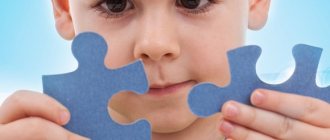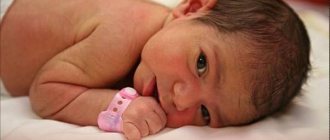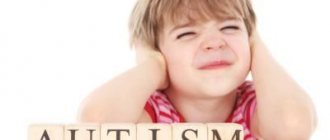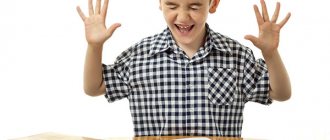Olga Tkatskaya
Games-activities for the development of fine motor skills in children with severe cerebral palsy
Games and activities are intended for teachers of inpatient social service institutions working with children with SMDD; parents.
The classes are aimed at developing fine motor skills in children with cerebral palsy .
The purpose of these games is to introduce teachers and parents to work on the development of motor skills , which ultimately affects the development of speech and thinking .
Fingers.
Progress of the lesson.
1. Massage the hands and fingers with walnuts.
Rolling one palm of the hand over the other from the back and inside, squeezing the nut in the palm with all fingers, rolling the nut between the fingers.
I'm rolling my nut
To become rounder than everyone else.
Dry sand games.
Pour dry sand into a container in a layer of 7–10 cm. Invite the child to play with the sand. Take sand in your hands, pour it through your fingers, and knead it with your fingers.
The child claps his palms on the sand, moves his fingers, sticks his fingers into the sand, “drowns”
hands in the sand.
We take a strainer from the kit and sow sand through it. We collect sand in containers and pour it out.
Then the teacher buries small toys in the sand and invites the child to find them.
3. Bottom line.
- How interesting it is to play with sand, did you like it?
Jars.
Goals.
1. Formation of manual skills in unscrewing and tightening the lids of jars.
2. Correction of hand-eye coordination based on practical actions with objects.
3. Cultivate patience.
Materials: 3-4 different jars of cosmetics with different items inside: button, pebble, nut, candy.
A set of correctional and developmental exercises for children with cerebral palsy
GBOU School 166 DO "Solnyshko"
A set of correctional and developmental exercises
for children with cerebral palsy
Prepared by:
Pirogovskaya O.A.
Moscow 2020
The exercises are aimed at developing tactile skills, fine and gross motor skills, grip, pouring, pouring, the relationship between size and shape.
The main rule is the desire of the child and the availability of free time from the parents. The lesson time is approximately 15-20 minutes, you can do several exercises in a row, depending on the child’s strength. Classes 2-3 times a week. You can do it every day, but no more than 2-3 exercises.
Magic bag:
Goal: to develop tactile-motor perception.
Tasks: Corrective and developmental:
- Develop spatial orientation.
- Develop attention, memory, thought processes and operations.
- Develop coordination of movements
- Create a feeling of joy for your actions
You will need any small bag filled with toys familiar to the child. Using the left or right hand, the child “catches” objects without looking inside. When pulling out an object, the adult describes the object, showing it to the child.
“Find all the treasures or the box of cereal.”
Target. Develop tactile sensations, stimulate the development of sensory perception, activate active points.
Description of the game . Hide small toys in a tray with different types of cereals. Game situation: “There is a treasure hidden at the bottom of the sea, let’s find it.” Give the child the opportunity to come into contact with the cereal, thereby providing a natural massage of the palms and fingers. When the child pulls out a toy or object, talk about it. You can also offer various containers and children's dishes so that the child can pour the cereal.
"I am an artist".
Target. Learn to work with two hands, develop large and fine motor skills, develop creative abilities, train hand coordination.
Description of the game . The child is offered a tray with semolina. Show how you can draw with your finger on the rump. You can draw whatever you want.
"We are musicians."
Target . Develop auditory perception, attention, thinking.
Description of the game . In the presence of a child, pour different types of cereals into identical containers and show how they sound. And then invite the child to be a musician, clarifying that large grains are louder, and small grains are quieter.
"Pattern"
Goal: development of fine motor skills of the hands, coordination of movements, color perception.
You will need a mosaic tablet. Together with your child, insert several mosaic pieces to form a pattern, and then offer to pull the rubber bands onto the mosaic caps. Be sure to make sure your child uses both hands.
If there is no mosaic, then it is allowed to use cardboard, a piece of foam plastic, a cork board with inserted safe needles (ADULT SUPERVISION IS MANDATORY). And also invite the child, together with an adult, to put on rubber bands, making a pattern.
Speech gymnastics
Recommendations for conducting speech gymnastics:
1.Ventilate the room! There should be fresh cool air in the room where classes are held.
2. We exercise no earlier than an hour after eating! Best on an empty stomach.
- Clothes are loose and do not restrict movement.
- We make sure that there is no tension in the arms, legs, neck, chest.
- We remember that the load with breathing exercises should be dosed. Otherwise, we will get such a symptom of hyperventilation as dizziness and other unpleasant sensations.
- Do not engage in the acute stage of respiratory diseases.
Exercises on forming an air stream.
- "Put the ball into the goal"
Pull your lips forward with a tube and blow on the cotton ball for a long time, trying to make it fly between two cubes.
- “Who will kick the ball further?”
Smile and place the wide front edge of your tongue on your lower lip. Blow for a long time so that the air stream goes in the middle of the tongue, and blow the cotton wool onto the opposite edge of the table.
- "The engine whistles"
Take a clean bottle and bring it to your mouth. Stick out the tip of your tongue slightly so that it only touches the edge of the neck. Exhale air smoothly into the bubble. If the whistle does not work, there is no need to be upset, it means that some rule of the game has not been fulfilled. You should start over.
- "Focus", "Parachute"
Open your mouth slightly, push your tongue forward with a cup and lift it, exhale smoothly onto the cotton wool lying on the tip of your nose, or onto your bangs.
The cotton wool can be attached to the thread!
- "Bean Race"
The candy box is equipped as a track for the “bean” runners, and they start running with the help of the “wind” from cocktail tubes. The winner is the one who catches his “runner” to the finish line faster.
- “Whose figurine will fly farther?”
On the tables there are figures of birds, butterflies, flowers, fish, and snowmen cut out of thin paper (or napkins). Each child sits opposite his figurine. You should move the figure only with one exhalation; you cannot blow several times in a row. The signals “fly”, “swim”, “ran” indicate movement for different figures. Some children blow on the figures, while the rest watch.
- "Add a syllable"
The teacher pronounces 2,3,4 or more syllables. And the child has one more syllable each time. For example, an adult: “pa-pa-pa”, a child: “pa-pa-pa-pa”.
- "Snowflake"
Place a “snowflake” (paper square) measuring 1x1 cm on the tip of your tongue and blow it off, as if pronouncing the sound “F”.
- "Storm in a glass"
Place a cocktail straw in the middle of the tongue, the end of which is placed in a glass of water. Blow through the straw to make the water in the glass bubble.
- "Top"
Use a directed stream of air to spin the top (or spinner). Be careful not to swell your cheeks. The air stream should go in the middle of the tongue.
- "Holiday joke tubes"
Under the influence of exhaled air, the paper tongue unwinds
- "Bubble"
Hold competitions. The winner is the one who blows the biggest bubble. Or whoever gets the most bubbles.
- "Ship"
You will need a bowl of water and paper boats (or boats made from walnut shells). In order for the boat to move smoothly, you need to blow on it slowly, with your lips pursed, as for the sound [F]. To imitate a gusty wind, the lips are folded, as for the sound [p]: “p-p-p”. You can blow with your lips stretched out with a tube, but without puffing out your cheeks.
- "Firework"
Put a ring with New Year's rain on the straw. Blow into a straw and the rain turns into fireworks.
Progress of the lesson.
1. Massage of hands and fingers.
One, two, three, four (Children clench and unclench their fists.)
We washed the dishes. (Rub one palm against the other.)
Teapot, cup, ladle, spoon
And a big ladle. (Bend your fingers, starting with the big toe.)
We washed the dishes, (Again he rubs one palm against the other.)
We just broke the cup, (Bend the fingers, starting with the little finger.)
The ladle also fell apart ,
The teapot's nose is broken,
We broke the spoon a little. (Clench and unclench their fists.)
So we washed the dishes.
Goals.
1. Stimulation of kinesthetic sensations and development based on finger touch.
2. Correction of hand-eye coordination based on practical actions.
3. Cultivate interest in a new type of activity.
Materials: a container with warm water 15–20 cm high, small pebbles, shells, fish toys.
What are we doing wrong?
“In our country it is very difficult to get an honest answer,” says pediatric neurologist Anna OSTROVERKHOVA .
– Parents have a vague idea of what results they can expect from rehabilitation, they seize every opportunity to show their child to a “fashionable” doctor, get a second (read: “one hundred and fifth”) opinion, they look for those who promise to put the child on his feet, sometimes giving his last money to miracle procedures, magic medicines. Most parents believe that everything depends on perseverance and intensity of activities: if you actively engage, then the child can be “stretched” and he will walk. Behind the idea of restoring the child, the child himself is lost.
His entire childhood passes under the banner of rehabilitation; often there is no time left for childhood itself: endless painful and completely ineffective injections of nootropics and vitamins, courses of useless massage, exercise therapy through pain and tears. Very often, efforts are made in completely the wrong direction: complex and ineffective activities are carried out, and there is not enough strength, time, or understanding for simple but vital things, or understanding that these actions are the only thing the child really needs.
I see children with severe cerebral palsy (level V according to GMFCS), who are “treated” all their lives, receive courses of nootropics and drugs that improve cerebral circulation, and receive monthly massages. After 10-14 years, the parents of a child with tetraparesis, with severe contractures, with spastic dislocations/subluxations of the hips, severe pain, severe underweight have only one request: to remove tone and contractures, so that the child does not suffer from pain, so that there is a little easier to care for. They no longer expect him to speak or even learn to hold his head up.
Why are there no such “neglected” children (whom our parents desperately “treated” all their lives) in developed countries? What do they do differently from us?
Firstly, parents receive a detailed diagnosis that determines the level of the child’s motor and communication functions. Secondly, knowing the degree of impairment of motor functions on the GMFCS scale, doctors determine the rehabilitation prognosis and potential of the child and honestly inform his parents, without feeding the parents’ unrealistic dreams and hopes for the child’s full recovery. Thirdly, adequate rehabilitation goals are chosen.
In the example described above, the child will most likely be placed on a baclofen pump to reduce tone, surgical treatment is possible to reduce pain, parents will use special positioning techniques to prevent contractures, the child will receive adequate nutrition, and will undergo medical examinations, including x-rays of the hip joints. The family will be provided with psychological support, parents will be taught alternative ways of communicating with the child.
But this is another illustration of the fact that a bitter truth is better than a sweet lie. Yes, the child will also not have the ability to move independently and perform purposeful actions, but he will be of adequate weight, without contractures, dislocations and pain, most likely he will have the strength for non-verbal communication, and it will be much easier for parents to care for him in adolescence."
Progress of the lesson.
1. Massage of hands and fingers.
"Pickling cabbage"
We chop the cabbage, chop it, (With the edge of one hand we tap the back of the palm of the other hand.)
We three carrots, three, (Rub the bones of the bent fingers into the palm.)
And now we salt, salt, (Imitate sprinkling salt.)
We press well, we press. (Clench and unclench your fingers.)
2. Finger painting.
The teacher shows the child a pot with a flower.
- Look, the flower’s head is down. He's probably thirsty. I need to water the flower. But as? From a watering can.
The teacher takes a toy watering can and waters the indoor flower.
— Water flows from the watering can like rain. And in this picture the flower also drooped, lowered its head, probably no one had watered it for a long time. Let's draw rain in our picture, let the flower drink.
— Show me how the rain drips? Tap your palm with your finger.
Rain, rain,
Drip-drip-drip!
Wet paths.
We can't go for a walk -
We'll get our feet wet.
The teacher shows the child how to dip his finger in the paint and leave a mark on the paper. The child, under the guidance of the teacher, draws colored dots.
3. Bottom line.
Get younger! You drew rain and watered the flowers.
We play with cubes.
Goals.
1. Formation of the grasping function of the hand.
2. Correction of hand-eye coordination based on practical actions with objects.
3. Foster a sense of joy from joint activities.
Materials: small red and slightly blue building blocks, a toy car, a massage hair brush.
How to control the gait of children with cerebral palsy whose knees are bent backwards (recurvation)
During recurvation, the muscles of the back of the thigh are weakened (hamstring group). These muscles need to be strengthened. You can lie on your back and bend your leg so that your heel touches your buttock. Then you can also do it with a weighting agent. The same leg lift can be performed while standing, you just need to make sure that the knee is pointing down and the supporting leg does not go into recursion. Also, the child must be taught to stand and walk with his knees bent. And it is necessary to use special orthoses.
Progress of the lesson.
1. Massage of hands and fingers.
Doll Masha kneaded dough, (Clench and unclench her fists.)
She kneaded dough and baked cookies. (Clap with half-bent palms.)
She gave all the guests: (Curb your fingers, starting with the little finger.)
I gave it to the bunny, I gave it to the fox,
I gave it to the squirrel, I gave it to the bear,
And she drove away the evil wolf. (Wag your index finger.)
2. Exercise with salt dough.
The teacher places a larger piece of dough on the table.
- This is the dough the doll Masha kneaded. (Gives the dough to the child’s hands so that he can knead it.)
This is how the doll kneaded the dough.
Flatten the dough on the table with your palms, and then press it down with your fingers, making dots with your fingertips. Crumple again into a piece. The teacher divides the dough into three pieces, taking one for himself and the other for the child.
- We'll make cookies. Take a piece in your palm and roll the ball. Now press the ball with your palms. It turned out to be cookies. Now we will decorate it. Pinch off small pieces of dough from a piece of a different color. Roll small balls with your fingers and press them into the “cookies”
. From the remaining piece you can roll the sausage and make a ring. The teacher helps the child as needed.
3. Bottom line.
Did you like sculpting with dough? What did you make? Who will you treat with cookies? He will tell you: “Thank you!”
Sun.
Goals.
1. Formation of manual skills : attaching clothespins.
2. Correction of visual-auditory attention based on focusing on the speech and actions of an adult.
3. Cultivating a feeling of joy from a correctly completed task.
Equipment and materials: 6-7 clothespins, preparing a sun without rays.
Study area
Before starting training, it is important to choose the correct position of the child and fix it. The position should be natural so as not to strain the muscles and joints, but at the same time allow the child to remain active at the maximum level possible for him. Feet should rest on a hard surface: the floor or a special stand. The knees, ankle and hip joints should be at an angle of 90 degrees.
Footrest with height and tilt adjustment for 1,400 rubles
The correct position of the child at the desk prevents joint deformation and the formation of secondary disorders - for example, scoliosis or joint dislocation. If the child sits comfortably and is well supported, he does not need to be distracted by supporting his body and can concentrate on his activities.
Desk. The desk or table should not be large so that the child does not have to reach for distant objects. The table should contain a lamp, a book stand and writing utensils. The book stand should be stable, and the lamp and cups for the stationery can be hung on the wall so that they do not accidentally fall - but only if it is convenient for the child and he can reach them. If a child uses a stroller, he needs a table that is height adjustable.
A perforated panel from Ikea for 900 rubles, on which you can hang cups with pencils
Chair. If the child does not use a stroller, he will need a growing chair, pelvic clamps and vests that keep the body from falling to the side. When a child does not hold himself with his hands, he can do something with them: write, draw or assemble a puzzle.
The study chair for 31,000 rubles is adjustable in seat depth, height and inclination of the back, armrests and footrest. It is equipped with safety straps and a leg extension roller
Computer. A stationary computer can load the zone; it is better to choose a monoblock: it is stable, has a large diagonal and takes up little space. A laptop is less suitable: it needs to be placed close to your eyes, and involuntary hand movements lead to unnecessary presses on the keyboard. On a candy bar, you can remove the keyboard completely and use only the mouse.
Lenovo monoblock for 23,000 rubles with a diagonal of 19.5 inches, the screen angle is adjustable. You can hide the power cord behind the table and buy a wireless mouse and keyboard
Lighting. The work area should be well lit so that the child can see everything and can concentrate. A table lamp is needed so that the child can turn it on and off himself, for example, a touch lamp.
Touch table lamp for 1055 rubles with three brightness levels
If a child has reduced vision, the work area can be made contrasting: add bright objects or colored tape.
You can additionally screw an anchor to the table - a wooden or rubberized handle. It is useful if the child performs tasks with one hand, for example, writing or drawing. At this time, the second hand may be in motion due to hyperkinesis and, to get rid of the imbalance, the child can grab the anchor.
“Anchor” handles of different shapes, with support and fastenings, priced from 28,000 to 40,000 rubles
Progress of the lesson.
1. Massage of hands and fingers.
Exercise “Master made a locker”
.
The master made the cabinet, sawed the boards straight.
(Place your palm with an edge and “saw”
on the surface of the other palm.)
He hit them with a hammer, as if he were hammering nails.
(Clench your hand into a fist and lightly tap your palm and fingers.)
I made the doors.
(Connect the side surfaces of your thumbs, open and close the “doors”
.)
He couldn't make the key.
(Join the fingers of both hands into a “lock”
, thumbs together and hide them inside
the “lock”
.)
2. Exercise with a miracle bag.
The teacher shows the child the bag, lets him touch it and examine it.
- Now we will hide various objects in the bag.
The child takes one object at a time, names it and puts it in a bag, the teacher helps.
— This is a massage ball, it is small and prickly. This is a bunny, he is soft, fluffy and warm. This is a spoon, it is smooth and cold. This is a cube, it has corners.
- All the items were hidden in the bag, they are now invisible. (The teacher shakes the bag.)
Place your pen in the bag and find the ball in it.
The child feels the object, tries to recognize it and takes it out. The teacher approves of him with praise. And so are all objects.
3. Bottom line.
— Did you like playing with the bag? Was it difficult to find items in the bag? Well done, you tried and found all the items correctly.
Lesson 14. House for bunnies.
Goals.
1. Develop motor reactions (clap your hands, tilt your head to the sides)
.
2. Correction of fine motor skills based on verbal instructions and demonstration by an adult.
3. Cultivate friendly relationships between a child and an adult.
Equipment: a toy hare, a recording of a dance melody, 2 cubes and a triangular prism from a building set, a lock.
Game Zone
The child’s play area should be created taking into account the functional level:
- children with the first level can walk, run and jump;
- with the second - they walk, but cannot lift their legs from the support, for example, jump;
- children with the third level can sit and crawl;
- fourth level - children who can only sit with support and cannot maintain a position without a support;
- fifth level - bedridden patients.
A child of levels 1–2 will have the same play area as a healthy child: soft carpets for playing on the floor, shelves and racks with books and toys at an accessible height. Containers with toys should be placed on the floor so that it is convenient to get toys and there is no risk of dropping the box on yourself.
If your child has a weak grip or poor hand coordination, you can replace the handles on the chest of drawers and cabinets with thicker ones - this will make it easier to open the drawers. If possible, sharp corners should be removed or covered with protective caps.
If the child does not move independently , there should be as little soft covering as possible on the floor so that the wheels of the stroller do not slip and get tangled. The wires need to be hidden in cable channels. You can also lay soft floor puzzles. They're easy to clean, collect less dust than carpet, and cushion falls.
Sometimes children play lying down or reclining in the play area, then you can leave a soft rug on the floor in this place. Large soft cubes can also be useful: you can lean on them, put objects on them that you need to reach, or stack the cubes on top of each other.
If a child plays while sitting, you need to monitor his posture and body position. For example, in the W, or frog, pose, the joints are in the wrong position and there is a risk of dislocating the hip joint. To prevent this from happening, place a wedge-shaped seat under the basin - it can be rolled up from a terry towel.
Wedge-shaped orthopedic seat cushion for 2100 rubles










